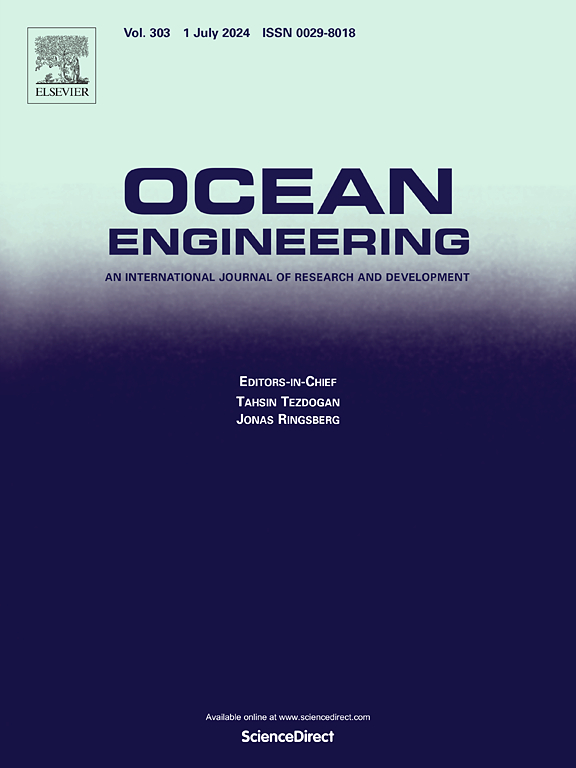Local buckling and compressive strain capacity of metallurgically clad pipes with dent defects at girth welds
IF 5.5
2区 工程技术
Q1 ENGINEERING, CIVIL
引用次数: 0
Abstract
Metallurgically clad pipes (MCPs) have effectively addressed corrosion issues associated with deep-sea oil and gas transportation. However, MCPs frequently suffer dent damage resulting from third-party impacts during the installation and operational conditions. Such dent defects may precipitate local buckling failures under combined loading scenarios involving bending moments, axial forces, and internal pressure. In this study, a three-dimensional finite element model incorporating girth welds is developed to investigate the local buckling failure mechanism of MCPs induced by dents located in weld regions under combined loading conditions. Traditional strain-based assessment approaches are inherently limited and thus inadequate for evaluating MCPs with dent-induced damage in the girth weld area. To overcome this limitation, a novel calculation method utilizing the far-field average strain approach is proposed to predict local buckling failure accurately. Comprehensive analyses examine the influence of critical parameters, namely including bending moment, internal pressure, external pressure, dent depth, and the spatial proximity between dents and girth welds, on the MCP's buckling behavior and compressive strain capacity. The proposed method is validated through comparisons with established critical buckling failure loads. Results indicate that dents near girth weld regions significantly compromise the limited compressive strain capacity of MCPs, with dent depth, internal pressure, and external pressure notably influencing the local buckling failure modes. A predictive formula quantifies the limited compressive strain capacity, incorporating the effects of external pressure, internal pressure, dent depth, and dent-to-weld distance. The prediction errors are all within 10 %, satisfying the requirements of practical engineering applications. The proposed method provides a valuable reference for the integrity assessment of metallurgically clad pipes.
环焊缝有凹痕缺陷的冶金包层管的局部屈曲和压缩应变能力
金属包层管道(mcp)有效地解决了与深海油气运输相关的腐蚀问题。然而,mcp在安装和运行过程中经常会受到第三方的冲击而造成凹痕损坏。在包括弯矩、轴向力和内压在内的综合载荷情况下,这种凹痕缺陷可能会导致局部屈曲破坏。在本研究中,建立了包含环焊缝的三维有限元模型,以研究复合加载条件下焊缝区域凹痕引起的mcp局部屈曲破坏机制。传统的基于应变的评估方法具有固有的局限性,因此不足以评估环焊缝区域具有凹痕损伤的mcp。为了克服这一局限性,提出了一种利用远场平均应变法精确预测局部屈曲破坏的计算方法。综合分析考察了关键参数对MCP屈曲行为和压应变能力的影响,包括弯矩、内压力、外压力、凹痕深度以及凹痕与环焊缝之间的空间接近度。通过与已建立的临界屈曲破坏载荷的比较,验证了所提方法的有效性。结果表明,环焊缝附近的凹痕显著降低了mcp的极限压应变能力,凹痕深度、内压和外压显著影响mcp的局部屈曲破坏模式。一个预测公式量化了极限压缩应变能力,包括外部压力、内部压力、凹痕深度和凹痕到焊缝距离的影响。预测误差均在10%以内,满足实际工程应用的要求。该方法为金属包层管道的完整性评价提供了有价值的参考。
本文章由计算机程序翻译,如有差异,请以英文原文为准。
求助全文
约1分钟内获得全文
求助全文
来源期刊

Ocean Engineering
工程技术-工程:大洋
CiteScore
7.30
自引率
34.00%
发文量
2379
审稿时长
8.1 months
期刊介绍:
Ocean Engineering provides a medium for the publication of original research and development work in the field of ocean engineering. Ocean Engineering seeks papers in the following topics.
 求助内容:
求助内容: 应助结果提醒方式:
应助结果提醒方式:


